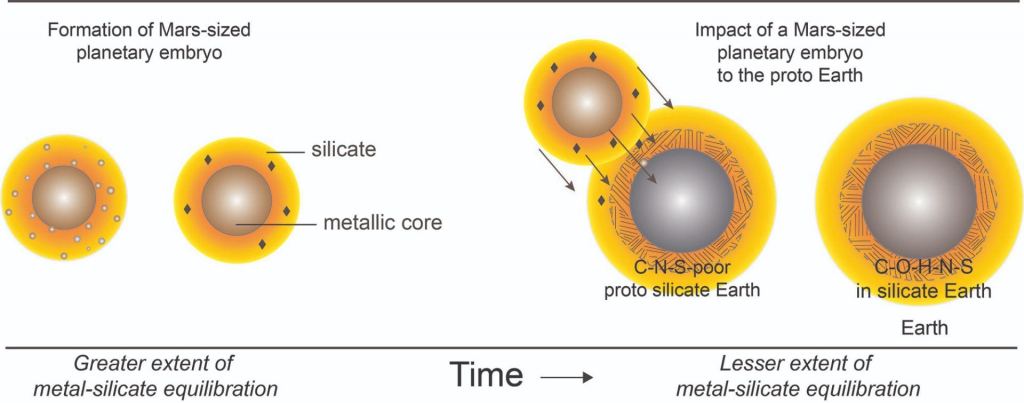The Earth wasn’t formed containing the necessary chemicals for life to begin. One well-supported theory, called the “late veneer theory”, suggests that the volatile chemicals needed for life arrived long after the Earth formed, brought here by meteorites. But a new study challenges the late veneer theory.
Evidence shows that the Moon was created when a Mars-sized planet named Theia collided with the Earth. The impact created a debris ring out of which the Moon formed. Now, this new study says that same impact may have delivered the necessary chemicals for life to the young Earth.
“Ours is the first scenario that can explain the timing and delivery <of volatiles> in a way that is consistent with all of the geochemical evidence.”
Co-author Rajdeep Dasgupta, Department of Earth, Environmental and Planetary Sciences, Rice University.
The impact between Earth and Theia occurred about 4.4 billion years ago, very early in Earth’s life. That’s when the Earth most likely received most of its carbon, nitrogen, and other volatile chemicals necessary for life to exist. The new study is from Rice University and is published in the journal Science Advances.
Scientists have studied primitive meteorites from the early Earth and the other rocky planets in the inner Solar System. They’ve found that the ancient meteorites are depleted of volatile chemicals necessary for life. That begged the question, where did Earth’s volatile chemicals come from?
“From the study of primitive meteorites, scientists have long known that Earth and other rocky planets in the inner solar system are volatile-depleted,” said study co-author Rajdeep Dasgupta. “But the timing and mechanism of volatile delivery has been hotly debated. Ours is the first scenario that can explain the timing and delivery in a way that is consistent with all of the geochemical evidence.”
According to the team behind the study, the impacting planet had a sulfur-rich core, while its mantle and crust contained volatiles. When it collided with the Earth, it injected the chemicals necessary for life, like nitrogen, carbon, hydrogen and sulfur, into the Earth’s crust. The collision also ejected massive amounts of material into space, which coalesced into the Moon.
Damanveer Grewal, study lead author, grad student, Rice University.
“What we found is that all the evidence … are consistent with a moon-forming impact involving a volatile-bearing, Mars-sized planet with a sulfur-rich core.”
The team behind this study performed experiments in a lab that mimics the high-pressure and high-temperature conditions found when a planet’s core is formed. The experiments helped test their theory that says volatiles came to Earth as a result of a collision with a planet with a sulfur-rich core.
The sulfur content of the donor planet’s core matters because of the puzzling array of experimental evidence about the carbon, nitrogen and sulfur that exist in all parts of the Earth other than the core. “The core doesn’t interact with the rest of Earth, but everything above it, the mantle, the crust, the hydrosphere and the atmosphere, are all connected,”
study lead author and graduate student Damanveer Grewal said. “Material cycles between them.”
They tested the idea with a hypothesized Earth core containing varying levels of sulfur. They wanted to know if a high-sulfur core excluded carbon, nitrogen or both. Overall, they found that the greater the sulfur content of the core, the less likely it is that it will contain volatiles. At least in Earth’s case.

A schematic depicting the formation of a Mars-sized planet (left) and its differentiation into a body with a metallic core and an overlying silicate reservoir. The sulfur-rich core expels carbon, producing silicate with a high carbon to nitrogen ratio. The moon-forming collision of such a planet with the growing Earth (right) can explain Earth’s abundance of both water and major life-essential elements like carbon, nitrogen and sulfur, as well as the geochemical similarity between Earth and the moon. (Image courtesy of Rajdeep Dasgupta)
Nitrogen was largely unaffected,” Grewal said. “It remained soluble in the alloys relative to silicates, and only began to be excluded from the core under the highest sulfur concentration.”
Using the results of these experiments, they ran over a billion simulations to find out how Earth could have gained its volatile chemicals. “What we found is that all the evidence — isotopic signatures, the carbon-nitrogen ratio and the overall amounts of carbon, nitrogen and sulfur in the bulk silicate Earth — are consistent with a moon-forming impact involving a volatile-bearing, Mars-sized planet with a sulfur-rich core,” Grewal said.
The implications of this study are about more than just Earth. They also tell us something about how life may come to be on other rocky planets in other solar systems.
“This study suggests that a rocky, Earth-like planet gets more chances to acquire life-essential elements if it forms and grows from giant impacts with planets that have sampled different building blocks, perhaps from different parts of a protoplanetary disk,” Dasgupta said.
“This removes some boundary conditions,” Dasgupta said. “It shows that life-essential volatiles can arrive at the surface layers of a planet, even if they were produced on planetary bodies that underwent core formation under very different conditions.”
Dasgupta said it does not appear that Earth’s bulk silicate, on its own, could have attained the life-essential volatile budgets that produced our biosphere, atmosphere and hydrosphere. “That means we can broaden our search for pathways that lead to volatile elements coming together on a planet to support life as we know it.”
The team’s work is part of the CLEVER Planets (Cycles of Life-Essential Volatile Elements on Rocky) Planets program.


Do we know any Solar Body containing Sulfur as Core material?
Or
do we know which part of Solar system can have abundant Sulfur so that migration towards proto earth could have interacted with Earth?
Since according to this study, Thea was supposed to have all the necessary Sulfur, Nitrogen and Carbon, then it could have developed its own life bearing system.